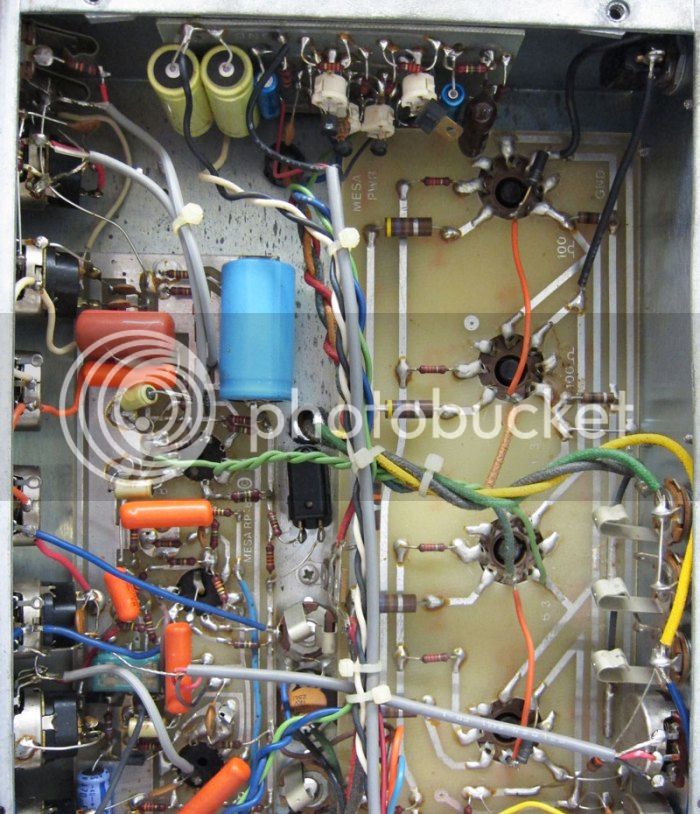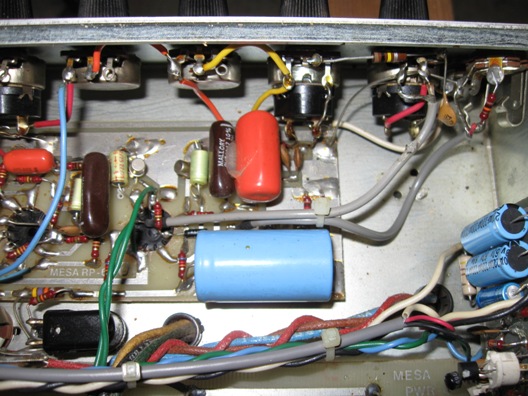Hi there.
Since this is my first post in this glorious forum, please bear with me .
.
I got my hands on a 1979 blonde mk ii a. This thing seem to be having work done on it, and i am having a hard time getting it back to its original.
Anyways, i got this problem with some of the ceramic caps. They are very microphonic. One in particular - right where i got huge noise problems ( https://www.youtube.com/watch?v=S6dCgj8c9ZM ).
So i'll try and replace it. Im struggling with the code on this thing. Please see my image. It says: "Z5U - .002M - 1KV".
My first thought was a .002 microfahrad. But via google it looks like its a .047microFahrad.
Can anyone confirm this?
I am writing a loooong article on this amp since it looks very modded and to me it looks like bad amateur work.
Here is my image (click to see. Too big for this forum):
https://dl.dropboxusercontent.com/u/109969/Musik/1979-mesa-boogie-mark-ii-b/z5u.jpg
On a sidenote. Since i noticed that there are not many images on google from the inside of a mark 2a, i have taken a lot of hi-res photos where you can zoom all the way in. So if you ever need to confirm, or just see what's inside a 2A, you can freely download my zip-files. The full-res is quite big. Hope you can make use. Its nice to have sometimes, just to confirm and such.
The links are:
web-resokution: https://dl.dropboxusercontent.com/u/109969/Musik/1979-mesa-boogie-mark-ii-b/web.zip
Full-resolution: https://dl.dropboxusercontent.com/u/109969/Musik/1979-mesa-boogie-mark-ii-b/fullsize.zip
 Lars
Lars
Since this is my first post in this glorious forum, please bear with me
I got my hands on a 1979 blonde mk ii a. This thing seem to be having work done on it, and i am having a hard time getting it back to its original.
Anyways, i got this problem with some of the ceramic caps. They are very microphonic. One in particular - right where i got huge noise problems ( https://www.youtube.com/watch?v=S6dCgj8c9ZM ).
So i'll try and replace it. Im struggling with the code on this thing. Please see my image. It says: "Z5U - .002M - 1KV".
My first thought was a .002 microfahrad. But via google it looks like its a .047microFahrad.
Can anyone confirm this?
I am writing a loooong article on this amp since it looks very modded and to me it looks like bad amateur work.
Here is my image (click to see. Too big for this forum):
https://dl.dropboxusercontent.com/u/109969/Musik/1979-mesa-boogie-mark-ii-b/z5u.jpg
On a sidenote. Since i noticed that there are not many images on google from the inside of a mark 2a, i have taken a lot of hi-res photos where you can zoom all the way in. So if you ever need to confirm, or just see what's inside a 2A, you can freely download my zip-files. The full-res is quite big. Hope you can make use. Its nice to have sometimes, just to confirm and such.
The links are:
web-resokution: https://dl.dropboxusercontent.com/u/109969/Musik/1979-mesa-boogie-mark-ii-b/web.zip
Full-resolution: https://dl.dropboxusercontent.com/u/109969/Musik/1979-mesa-boogie-mark-ii-b/fullsize.zip



























